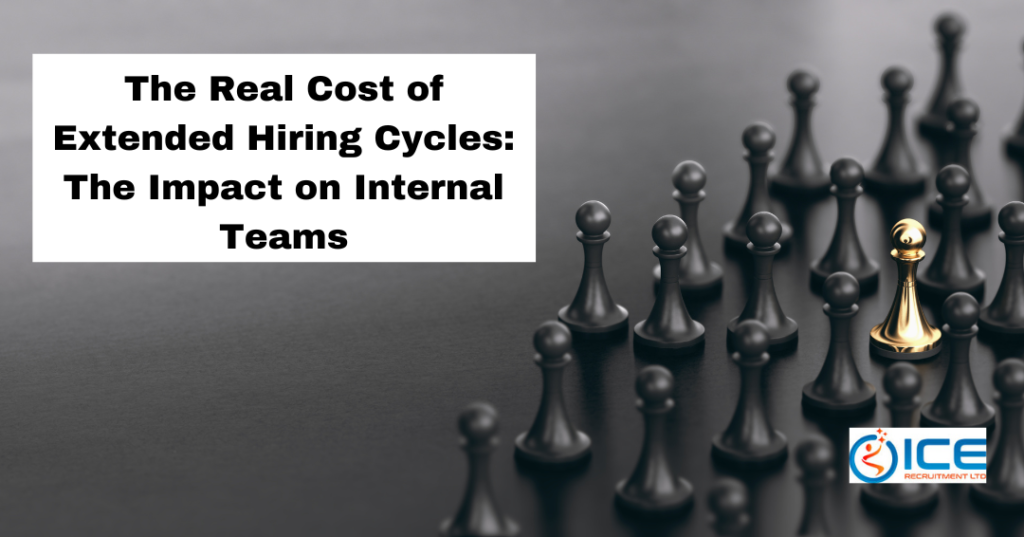Recruitment and hiring take time; most teams expect that. What many don’t realise is how much a long vacancy really costs.
We already know that the average cost of hiring an employee is around £4,700, according to SHRM.
That number is only the beginning. If you count lost output and other hidden costs, the impact can be closer to three to four times the yearly salary. A role paying £60,000 means losses of £180,000 or more.
Revenue can suffer too. One study found that company revenue can fall by over 5% when a critical sales role stays vacant. Plus, these gaps can also drive away good candidates. Potential employees want evidence that a company respects their time and value. A long hiring process can quickly drive candidates into the arms of competitors.
This report will show how a recruitment strategy that eliminates confusion and delays can help you make the right decisions faster, improve the candidate experience, and strengthen your employer brand.
The Current State of Hiring Cycles in the Technology Industry
Hiring has grown more complex, and many teams feel this every day. A process that once took weeks can now stretch into months. The average time to hire has increased across all industries. In some fields, it’s normal for roles to stay open for 60, 70, or even 90 days.
Several forces are at work.
Volume is one. Technology makes it easy for anyone to apply for several jobs at once. That means candidates can explore opportunities fast, but it also means hiring managers spend a lot more time sorting through applications.
Screening systems and AI can help filter through candidates faster. Still, studies show that AI can often accidentally filter out the best candidates, and most teams can’t afford to automate everything.
Expectations have changed, too. Companies want proof of skills, not just CVs. As the most important skills for crucial roles evolve, businesses are becoming more cautious about identifying the right employees. Most use extra interviews, assessments, and tests to understand applicants’ capabilities better.
That caution is understandable. A bad hire is expensive, too, but long delays have their own price. Vacancies pile up, and each one takes longer to fill. Over time, this backlog drains energy and focus.
Remote and hybrid work strategies can also add more hurdles. With teams across time zones, scheduling interviews takes longer, and decision-makers have less time. Recruitment/Hiring stalls not because no one cares, but because no one owns the timeline.
These problems create a slow, uncertain process, and candidates notice. Nearly 60% say they have had a poor hiring experience. About 72% share that story with others, meaning it becomes even harder to find the right people to fill roles over time.
Understanding the True Cost of Vacancies
Recruiting delays in the industry do much more than cause team frustration. They drain resources and funds much faster than many companies realise. You’re not just spending more on recruitment services or job ads. Over time, extended vacancies can drain so much value from a business.
Direct Financial Costs
Some expenses show up right away. Job boards, recruitment fees, and background checks cost money. However, one of the biggest direct costs is lost output. When a role stays empty, the work doesn’t disappear. It stops moving forward, or the remaining employees are left scrambling to fill the gaps.
One report found that unfilled roles and inefficient recruitment cost UK businesses around £132.6 million in lost productivity. That doesn’t even account for your team’s time screening candidates, setting up interviews, and following up with potential applicants.
It also doesn’t account for the cost of restarting the process if a candidate withdraws at the last minute or abandons it because your recruitment strategy is too slow.
Revenue Impact
The losses can be more visible when the role is tied to sales or revenue. Missing salespeople lead to fewer deals closed, and an unfilled managerial role leaves teams without direction. Projects often get delayed even if other team members pitch in to help.
This can harm client relationships over time, as customers grow frustrated. Overworked employees can sometimes make more errors, damaging trust in your company. These gaps don’t just hurt this quarter’s results. They can weaken your position against competitors over the long term.
Indirect and Hidden Costs
Other costs are harder to measure but often just as damaging. When roles remain unfilled, other employees step in to cover. At first, teams find ways to cope. Over time, that effort starts to take a toll. People work longer hours. They split focus across too many priorities. Burnout grows slowly until it shows up as turnover.
Organisations without backup or succession plans often struggle to move internal talent quickly enough to fill the gaps. This strain affects morale. It erodes trust in leadership. Teams start to feel that vacancies are just part of the landscape, with no plan to fix them.
Employer Brand and Candidate Experience
Vacancies don’t stay invisible. Candidates notice delays. They wait weeks for updates or see job postings linger without movement. This experience shapes their view of the company. That’s particularly true when staff members and candidates share their knowledge on employer review websites and social media.
Over time, this damages your employer’s brand, making it harder to attract skilled people in the future. Even candidates who don’t take the job may still discuss how they were treated.
Rising Compensation Pressure
Finally, there’s the pressure to close a deal when the process drags on too long. As vacancies grow more urgent, hiring managers may feel compelled to raise offers, promising more benefits or higher salaries.
In tight markets, this can mean thousands in extra pay to close the process. Plus, if other team members see you offering higher wages to new employees, they may attempt to renegotiate their salaries.

Calculating Cost of Vacancy (COV): A Practical Framework
Many leaders sense that unfilled roles are expensive, but few track the exact numbers. Measuring vacancy costs clearly makes it much easier to set priorities and make informed decisions.
The good news is that you don’t need complicated models. A simple framework can give you a clear picture of what each day of delay costs your business.
Knowing your cost of vacancy helps in three ways:
- It gives you a real figure to weigh against recruiting investments.
- It helps you explain to stakeholders why timelines matter.
- It shows when a role is critical enough to need urgent action.
Step 1: Estimate the Role’s Annual Value
Start by working out how much value a role delivers to your business. That number can be based on revenue generated by a specific employee, productivity, or cost savings. For sales and revenue-focused positions, you can look at the income you expect that person to develop. For instance, most sales roles come with an expected quota.
For roles less directly tied to revenue, consider the impact the employee has on your company’s growth, performance, or efficiency levels.
A good rule of thumb is that an employee’s value is usually 1 to 3 times their annual salary. For instance, a person with a £60,000 salary might contribute around £180,000 in annual value.
Step 2: Break Down the Daily Impact
Once you know your employee’s annual value, break it down by the number of working days in a year. Most companies will use a 260-day work schedule (5 days x 52 weeks). This should give you an insight into the daily cost of a vacancy.
For example:
- Annual value: £120,000
- Daily value: £120,000 / 260 = £461 per day
This figure is the baseline cost of the work not getting done.
Step 3: Add Direct Recruitment Expenses
Vacancy costs also include direct expenses. These might be:
- Job advertisements
- Recruiter or agency fees
- Time spent by hiring managers in interviews
- Background checks and assessments
These costs vary but often total thousands per hire. SHRM research estimates the direct financial expense of filling a role averages 12-30% of the annual salary.
Step 4: Factor in Opportunity Costs
Opportunity costs are what you lose because the work isn’t happening. The absence of a vital employee could mean that you’re dealing with:
- Revenue delays because a sales lead wasn’t followed up.
- Projects pushed back because a technical expert wasn’t available.
- Clients who leave due to slower service.
Ask yourself exactly what your business could miss out on because you don’t have access to the right people. The impact could be bigger than you think.
Step 5: Consider Indirect Costs
Indirect costs include:
- Burnout and turnover among existing staff.
- Lower morale and engagement.
- Damage to your employer brand.
You might not feel these effects immediately, but they can have a lasting impact. Just one delayed hire might lead to increased overtime, higher burnout rates, and more turnover, creating a cycle of constantly replacing crucial team members.
Using the Numbers
Once you have a clear estimate, you can:
- Prioritise the roles you need to fill faster.
- Justify investment in external support, or better tools.
- Set timelines and budgets for your new recruitment process.
You’ll also have a better process for determining how much value the right recruitment strategy delivers for your team.
The Ripple Effects: Beyond Financial Impact
Extended vacancies cost your company more than just money. They create strain that spreads across teams, harming your reputation, employees, and customer relationships. If you really want an accurate insight into the impact of long hiring cycles, you need to think about:
· Employee Burnout and Morale
When a position remains unfilled, the work left behind must be distributed among the remaining employees. At first, teams usually step up willingly. They care about their colleagues and don’t want to let standards slip.
Over time, though, the extra load starts to wear people down. Tasks pile up. Deadlines get tighter. Small frustrations grow. Employees who were once engaged begin to feel stretched and resentful.
Research shows that long-term overwork increases burnout and drives turnover. Even if your team members stick around, they might become disengaged and make more mistakes.
· Customer Service and Delivery
The effects don’t stop inside your organisation. When teams are short-handed, service slows down, small mistakes happen more often, and response times get longer.
Initially, clients might understand that you’re short-handed, but they expect you to fix the issue quickly. If you don’t, your customers will feel neglected or frustrated, which could mean they start looking for support elsewhere.
This erosion of trust is hard to repair. Even loyal customers can lose confidence if they feel your business isn’t equipped to meet their needs.
· Employer Brand and Reputation
Vacancies also affect how your company looks from the outside. When hiring drags on, candidates notice. They see old job postings with no updates. They wait weeks for feedback. Some never hear back at all.
This experience shapes how people talk about your business. People stop advocating for your company as an employer and start complaining about the candidate experience. Those negative reviews spread quickly, driving valuable talent away.
Over time, it becomes even harder to attract skilled professionals, which means the costs and side effects of slow hiring processes continue to add up.
· Loss of Innovation and Growth
When key roles are left open, innovation slows. Projects get delayed, and new ideas stagnate as teams wait for the right expertise to move processes forward. This can create serious risks in fast-moving segments of the industry.
Even if your business survives the short-term disruption, the long-term impact can be a weaker position in your market.
· Strategic Solutions and Best Practices
A long hiring cycle isn’t inevitable. It’s tougher to find and hire skilled professionals today, but you don’t have to let the complex market hold you back. Many delays that frustrate candidates and exhaust teams can be reduced with a few deliberate changes.
Here’s how your organisation can start taking positive steps.

Streamline the Hiring Process
- The first step is to look closely at your current process. Many companies have added steps over time without questioning if they are still needed. You might be navigating extra interviews, multiple approvals, or redundant assessments.
- Start by mapping every stage from job posting to offer. Notice where delays occur. Do interviews take weeks to schedule? How quickly do hiring managers share feedback or review assessment tests? One strategy could be to introduce parallel processing techniques.
- Instead of waiting for one step of the hiring process (like initial interviews) to be finished before you start the next, do multiple things simultaneously. Use Structured Interviews
- Unstructured interviews can often feel more natural, organic, and personal, but they create inconsistencies that slow your team down. They also make it much tougher to compare candidates on crucial criteria without bias.
- Structured interviews rely on clear criteria. Every candidate is asked the same core questions, and answers are scored using a simple scale. Every team member knows what they’re looking for. Some studies say structured interviews are twice as effective at predicting job performance.
- This approach saves time, reduces debates about who the “best fit” is, and improves fairness, which strengthens your employer brand.
Balance Technology and Human Touch
Technology can help move hiring forward. Applicant tracking systems, video interviews, and automated scheduling all save time. AI screening tools are great at filtering through applications and identifying promising candidates, but there’s a risk, too.
Although 87% of recruitment teams now use AI for hiring processes, 35% worry it might exclude people with valuable skills and experiences. Candidates don’t always trust AI tools to make fair assessments either. Relying on these systems too much could harm your employer brand.
The best companies find a balance. They use automation to handle repetitive tasks but keep personal contact at key moments. A quick phone call to update a candidate can make a big difference in trust.
Build Internal Mobility
Sometimes the fastest way to fill a role is to look at the people you already have. Many of your employees may have transferable skills and abilities that make them an ideal fit for a new role. Plus, since these team members know your systems and culture, they can usually step into new positions faster, with less training.
One Deloitte study even found that internal hires are 61% less likely to be fired during their first year in a new role. To make internal mobility work, you must ensure clear succession plans and give your teams the right resources to move across teams.
A simple internal job board and regular communication can help, too.
Improve Employer Brand and Candidate Experience
Candidates are not just evaluating the roles you have on offer. They are watching how you treat them during the process. Clear communication, prompt updates, and a respectful approach signal that your company values people, and that can make hiring processes much easier.
A few practices that improve experience:
- Send clear timelines when someone applies.
- Follow up after interviews, letting candidates know what to expect.
- Keep job postings updated, so candidates know which roles are available.
Remember, a positive experience will make candidates more likely to accept your offer or even recommend your company to their network.
ROI of Improving Hiring Cycles
Faster hiring isn’t just about efficiency. It brings real returns in your revenue, your team’s energy, and your ability to grow and innovate. When you take a proactive approach to shortening hiring cycles, you see massive gains like:
- Lower Cost per Hire: Costs increase when a process drags on. Extra rounds of interviews, longer advertising, and repeated candidate sourcing all increase expenses. When you cut unnecessary delays, you reduce these expenses. You also spend less on overtime and temporary cover for unfilled roles.
- Higher Acceptance Rates: Top candidates don’t wait forever. Every extra day increases the chance a candidate will drop out or accept another offer. By moving faster, you keep more qualified candidates engaged. This means better matches and fewer declined offers.
- Faster Time to Productivity: The sooner someone starts, the sooner they contribute. In sales or billable roles, even a few weeks make a difference. This early impact often pays back investments in better systems and training many times over.
- Reduced Turnover and Burnout: Filling roles promptly reduces the burden on existing staff. Over time, this lowers stress and burnout. Employees who don’t have to pick up extra work for months are less likely to look elsewhere. A stable team is more productive and easier to retain.
- Stronger Employer Brand: Candidates remember the experience. A fast, respectful process makes your company stand out. Even those who don’t get the job are more likely to recommend your brand, which means attracting new candidates becomes much easier.
Future Outlook and Recommendations
The hiring journey for teams is constantly changing. Today, we deal with new technology, client expectations, and ever-growing skill shortages. All those things affect how you bring new people into your team. In the future, we can expect:
- Technology to play an even bigger role: AI and automation are common parts of the hiring process today. These systems can speed up shortlisting, scheduling, and applicant screening, helping teams accomplish more with less. But it’s important to remember that technology alone isn’t the answer; you’ll still need to maintain a human touch.
- Skills-based hiring becomes the standard: Many companies are abandoning credentials alone. They want evidence that a person can do the work. Skills-based assessments, work samples, and scenario interviews are becoming more common, helping employers to find talent they might otherwise miss.
- Internal mobility matters more: Filling every role from the outside is costly and slow. Companies that want to stay agile will invest more time in succession planning and internal mobility strategies. That way, they’ll be able to make the most of the resources they already have when skill shortages are difficult to navigate.
Plus, candidates will expect more going forward, too. Job seekers have more access to information than ever. They read reviews, compare offers, and talk to each other.
This means your employer brand depends on a clear and fair process. Build a hiring strategy around transparent timelines, clear feedback and prompt responses. You’ll have a much easier time attracting candidates and convincing them to accept job offers.
Recommendations for Moving Forward
Here are a few steps to consider as you prepare for the future:
- Track the right metrics. Monitor time-to-hire, cost of vacancy, and candidate satisfaction. Use these numbers to guide improvements.
- Pilot faster workflows. Try streamlined processes in one department before scaling up.
- Invest in training. Help hiring managers learn structured interviews and skills-based evaluation.
- Strengthen internal mobility. Create clear paths for employees to explore new roles.
- Refresh your brand. Make sure your career site and communications with candidates reflect respect and clarity.
If you’re struggling, work with a recruitment team for expertise, support, and guidance on building a recruitment strategy that works for your business and your candidates.
Accelerate and Improve Your Hiring Strategies
Extended hiring cycles can wear down even the strongest teams. They chip away at time, budgets, and trust in quiet, steady ways that are easy to miss until the strain starts to show. When a role sits open too long, the impact isn’t just about money. Projects stall. People pick up extra work they weren’t hired to do. Good candidates drift away.
Fortunately, there is a solution. Making just a few simple changes to your hiring strategy can help you make decisions faster, impress potential candidates, and avoid burning out your remaining team members. All you need to get started is a little clarity.
Taking the time to calculate the true cost of vacancy gives you something solid to work with. It turns guesswork into real numbers you can plan around. Once you know what each delay costs your team, it’s much easier to set priorities and get everyone on the same page.
Moving faster doesn’t have to mean lowering the bar when choosing the best candidates. It means creating a foundation of trust and clarity. It means showing your team and candidates you value their effort and patience.
The cost of waiting is real, but so is the value of acting. Moving purposefully shows candidates and employees that your business is ready for what’s next.




